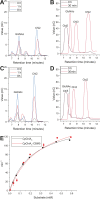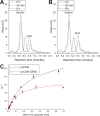A polysaccharide utilization locus from Chitinophaga pinensis simultaneously targets chitin and β-glucans found in fungal cell walls
- PMID: 37493618
- PMCID: PMC10449523
- DOI: 10.1128/msphere.00244-23
A polysaccharide utilization locus from Chitinophaga pinensis simultaneously targets chitin and β-glucans found in fungal cell walls
Abstract
In nature, complex carbohydrates are rarely found as pure isolated polysaccharides. Instead, bacteria in competitive environments are presented with glycans embedded in heterogeneous matrices such as plant or microbial cell walls. Members of the Bacteroidota phylum thrive in such ecosystems because they are efficient at extracting nutrients from complex substrates, secreting consortia of synergistic enzymes to release metabolizable sugars. Carbohydrate-binding modules (CBMs) are used to target enzymes to substrates, enhancing reaction rate and product release. Additionally, genome organizational tools like polysaccharide utilization loci (PULs) ensure that the appropriate set of enzymes is produced when needed. In this study, we show that the soil bacterium Chitinophaga pinensis uses a PUL and several CBMs to coordinate the activities of enzymes targeting two distinct polysaccharides found in fungal cell walls. We describe the enzymatic activities and carbohydrate-binding behaviors of components of the fungal cell wall utilization locus (FCWUL), which uses multiple chitinases and one β-1,3-glucanase to hydrolyze two different substrates. Unusually, one of the chitinases is appended to a β-glucan-binding CBM, implying targeting to a bulk cell wall substrate rather than to the specific polysaccharide being hydrolyzed. Based on our characterization of the PUL's outer membrane sensor protein, we suggest that the FCWUL is activated by β-1,3-glucans, even though most of its enzymes are chitin-degrading. Our data showcase the complexity of polysaccharide deconstruction in nature and highlight an elegant solution for how multiple different glycans can be accessed using one enzymatic cascade. IMPORTANCE We report that the genome of the soil bacterium Chitinophaga pinensis encodes three multi-modular carbohydrate-active enzymes that work together to hydrolyze the major polysaccharide components found in fungal cell walls (FCWs). The enzymes are all encoded by one polysaccharide utilization locus and are co-expressed, potentially induced in the presence of β-1,3-glucans. We present biochemical characterization of each enzyme, including the appended carbohydrate-binding modules that likely tether the enzymes to a FCW substrate. Finally, we propose a model for how this so-called fungal cell wall utilization locus might enable C. pinensis to metabolize both chitin and β-1,3-glucans found in complex biomass in the soil.
Keywords: Bacteroidota; Chitinophaga; carbohydrate-binding module; chitin; glycoside hydrolase; polysaccharide utilization locus; β-1,3-glucan.
Conflict of interest statement
The authors declare no conflict of interest.
Figures





References
-
- Kmezik C, Mazurkewich S, Meents T, McKee LS, Idström A, Armeni M, Savolainen O, Brändén G, Larsbrink J. 2021. A polysaccharide utilization locus from the gut bacterium Dysgonomonas mossii encodes functionally distinct carbohydrate esterases. J Biol Chem 296:100500. doi:10.1016/j.jbc.2021.100500 - DOI - PMC - PubMed
-
- Sangkhobol V, Skerman VBD. 1981. Chitinophaga, a new genus of chitinolytic myxobacteria. International Journal of Systematic Bacteriology 31:285–293. doi:10.1099/00207713-31-3-285 - DOI
Publication types
MeSH terms
Substances
Supplementary concepts
LinkOut - more resources
Full Text Sources

